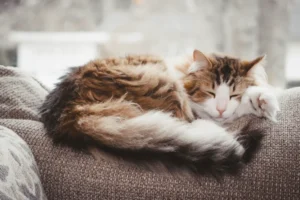Cats are known for their stealth, agility, and unique vocalizations. But have you ever wondered why cats do not roar like other big cats such as lions and tigers? The answer lies in the anatomy and evolution of these fascinating creatures.
Cats, especially domestic cats, do not have the physical capabilities to produce a roar due to the structure of their vocal cords and larynx. While lions and tigers have a specialized larynx that allows them to produce the deep, powerful roars that can be heard for miles, domestic cats have a more limited range of vocalizations. This is just one of the many intriguing aspects of feline biology that sets them apart from their larger relatives.
Evolutionary Adaptations of Big Cats
Big cats, such as lions, tigers, and leopards, have developed the unique ability to roar as a result of their evolutionary history. This powerful vocalization serves several crucial purposes in the wild. The ability to roar allows big cats to communicate over long distances, signaling their presence to potential mates and rivals alike. This deep, resonant sound demonstrates strength and dominance, helping to establish hierarchies within their social groups.
Furthermore, the roar serves as a warning to potential threats, deterring competitors and asserting their territory. This evolutionary adaptation has played a significant role in the survival of big cats in the wild, allowing them to navigate their environments and ensure successful reproduction.
For more in-depth information on the fascinating evolutionary adaptations of big cats and their roaring capabilities, check out this insightful article from National Geographic: National Geographic Article on Big Cats
Vocalizations of Domestic Cats
While big cats have developed roaring as a form of communication, domestic cats have a wide range of vocalizations to interact with their human companions and feline counterparts. From meowing to purring, each sound has a specific meaning and serves a unique purpose in their communication repertoire.
Meowing is primarily used by domestic cats to communicate with humans, indicating hunger, affection, or a desire for attention. On the other hand, purring is a sign of contentment and relaxation, often heard when a cat is being petted or cuddled.
Other vocalizations, such as hissing and growling, serve as warnings or signs of aggression when a cat feels threatened or territorial. By understanding these various sounds, cat owners can better interpret their furry friends’ needs and emotions, creating a stronger bond and enhancing their well-being.
Next time your cat meows or purrs, take a moment to listen and respond accordingly, strengthening your relationship and communication with your feline companion.
Comparison of Feline Vocalizations
Big cats, like lions and tigers, have the impressive ability to roar, a powerful sound that can be heard from miles away. On the other hand, domestic cats, such as tabbies and Siamese breeds, do not possess this roaring capability. Instead, they communicate through meows, purrs, chirps, and hisses. This stark difference in vocalization lies in the anatomy of their vocal cords. Big cats have a ligament in their voice box that can stretch to produce the deep, resonant roar, whereas domestic cats lack this specific adaptation. Apart from the vocal cord anatomy, the purpose of vocalizations differs as well. While big cats use roaring as a way to establish dominance, communicate with fellow pride members, and mark their territory, domestic cats rely on softer sounds to convey their needs and emotions to their human companions. So, next time you hear your feline friend meowing, purring, or chirping, remember that they have their unique way of expressing themselves that doesn’t involve roaring like their wild counterparts.
Role of Roaring in Big Cats
Roaring plays a crucial role in the lives of big cats, serving as a multifaceted tool for communication, territorial marking, and social bonding. When a lion or tiger roars, it can be heard up to five miles away, allowing them to communicate with members of their pride or other nearby individuals. This deep, resonant sound serves as a warning to potential intruders and helps establish territorial boundaries. Roaring also plays a significant role in social bonding within a pride, as it can help reinforce the hierarchy among members and maintain cohesion within the group. Additionally, roaring can be a way for big cats to attract mates during breeding seasons. Overall, the ability to roar is a vital adaptation that has allowed big cats to thrive in their natural habitats and maintain their status as apex predators.
- Roaring serves as a warning to potential intruders and helps establish territorial boundaries.
- Roaring is a way for big cats to communicate with members of their pride or other nearby individuals.
- Roaring plays a role in social bonding within a pride, reinforcing the hierarchy among members and maintaining cohesion within the group.
- Roaring can be used to attract mates during breeding seasons.
- Big cats use roaring as a powerful tool for survival, communication, and maintaining social structures in the wild.
Limitations of Domestic Cats’ Vocalizations
While big cats like lions and tigers can produce powerful roars that can be heard from miles away, domestic cats lack this capability due to physical differences in their vocal cords. Domestic cats have a higher-pitched vocal range and limited control over their vocalizations compared to their larger cousins. This limitation in vocal ability has influenced how domestic cats communicate, relying more on meows, purrs, hisses, and other subtle sounds to convey their messages.
Implications for Cat Behavior
The inability to roar has shaped the behavior of domestic cats in various ways. Since they cannot produce loud roars like big cats, domestic cats have evolved to communicate more subtly through body language and scent marking. They use tail movements, ear positions, and facial expressions to express their emotions and intentions to other cats and humans. Additionally, domestic cats have developed unique vocalizations, such as chirps and trills, to bridge the gap left by the lack of a roaring ability.
Ways Cats Communicate Without Roaring: 1. Meowing: Cats use different types of meows to communicate various needs and emotions. 2. Purring: Purring is a sign of contentment in cats and can also indicate pain or distress. 3. Hissing: Hissing is a defensive vocalization used by cats to signal aggression or fear. 4. Chirping: Cats may chirp to get attention or express excitement. 5. Body Language: Cats rely heavily on body language to convey messages, such as tail flicking or kneading.
By understanding how domestic cats have adapted their communication strategies due to their inability to roar, cat owners can better interpret their furry friends’ behaviors and strengthen their bond with them.
Fascinating Feline Facts
Did you know that the reason why cats do not roar like their larger feline relatives, such as lions and tigers, is due to a difference in their larynx structure? Cats have a flexible larynx that allows them to purr, meow, hiss, and growl, but they lack the specialized larynx structure needed to produce a roar. This unique feature sets domestic cats apart from their roaring cousins in the wild.
Another interesting fact is that cats’ vocalizations are not solely reserved for communicating with humans. Cats use a variety of sounds to communicate with each other and express their needs and emotions. So the next time your cat meows at you, remember that it’s not just seeking your attention; it could be trying to tell you something specific.
Cats also have a wide range of vocalizations that can vary depending on their breed, age, and personality. Some cats are more chatty and vocal than others, while some may be more quiet and reserved. Pay attention to your cat’s unique vocal repertoire to better understand what it’s trying to tell you.
Finally, next time your feline friend meows or purrs, remember that their vocalizations are a fascinating aspect of cat behavior that sets them apart from other animals in the feline family.
Insightful Angle:
A unique insight into feline vocalizations is that cats have developed different vocalizations to communicate with humans over time. Research suggests that cats have evolved to use meows, purrs, and other sounds as a way to communicate with humans, mirroring the way human infants use crying to get attention and care from their caregivers. This adaptation has helped strengthen the bond between cats and humans, making them even more endearing companions.
Additional Tip:
When deciphering your cat’s vocalizations, pay attention to the pitch, tone, and volume of their meows. Cats can use subtle variations in their vocalizations to convey different messages or emotions. By tuning in to these cues, you can better understand what your cat is trying to communicate with you.
Alex, a passionate animal lover, has experience in training and understanding animal behavior. As a proud pet parent to two dogs and three cats, he founded AnimalReport.net to share insights from animal experts and expand his knowledge of the animal kingdom.








